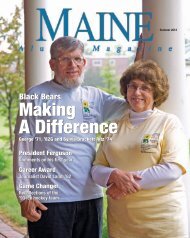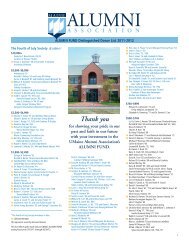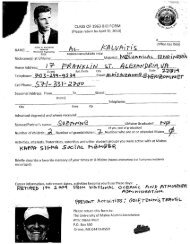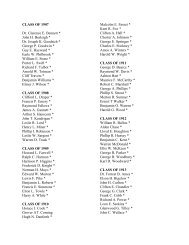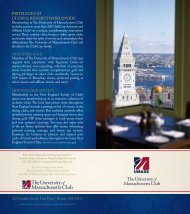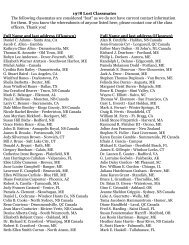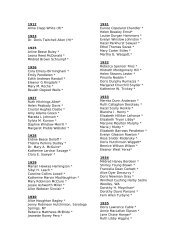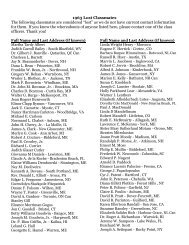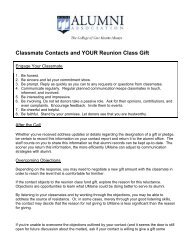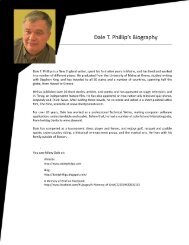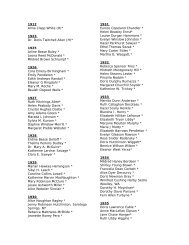UMaine's Diverse UMaine's Diverse - the University of Maine Alumni ...
UMaine's Diverse UMaine's Diverse - the University of Maine Alumni ...
UMaine's Diverse UMaine's Diverse - the University of Maine Alumni ...
You also want an ePaper? Increase the reach of your titles
YUMPU automatically turns print PDFs into web optimized ePapers that Google loves.
<strong>Alumni</strong> Winter 2012_Layout 1 1/6/12 10:32 AM Page 14<br />
<strong>Maine</strong> Lines<br />
Augusta during <strong>the</strong> 1960s and returned to broadcasting in <strong>the</strong><br />
1980s for State TV, where he ran <strong>the</strong> defensive driving program.<br />
Terry was one <strong>of</strong> <strong>the</strong> first to broadcast basketball and baseball on<br />
WMEB-FM, <strong>the</strong> <strong>University</strong>’s first non-closed circuit radio station.<br />
From <strong>the</strong>re, urged on by a favorite U<strong>Maine</strong> pr<strong>of</strong>essor, Terry earned<br />
a master’s degree in broadcasting at <strong>the</strong> <strong>University</strong> <strong>of</strong> Indiana,<br />
where an investigative reporting class landed him and several<br />
classmates in Sports Illustrated magazine.<br />
“At <strong>the</strong> time, <strong>the</strong>re were a number <strong>of</strong> colleges and universities<br />
cited for violations <strong>of</strong> <strong>the</strong> fire laws in Indiana. For example, Butler<br />
<strong>University</strong> had to cut <strong>the</strong>ir seating from 18,000 to 4,000 to stay<br />
within code. If <strong>the</strong>re had ever been a fire at a basketball game,<br />
because <strong>of</strong> <strong>the</strong> configuration <strong>of</strong> <strong>the</strong> exit doors, hundreds <strong>of</strong><br />
students would have been killed and injured. So my classmates<br />
and I decided to investigate whe<strong>the</strong>r <strong>the</strong> field house at Indiana was<br />
in compliance. We researched <strong>the</strong> formula, took our measuring<br />
tapes, and went out to measure <strong>the</strong> field house. We did <strong>the</strong> calculations<br />
several times to be certain and sure enough, Indiana would<br />
ei<strong>the</strong>r have to replace <strong>the</strong> doors or cut its seating capacity to 3,500.<br />
We really weren’t trying to cause trouble, so we went to <strong>the</strong> athletic<br />
department and showed <strong>the</strong>m our findings. We were dismissed<br />
out <strong>of</strong> hand. So at <strong>the</strong> urging <strong>of</strong> our pr<strong>of</strong>essor, we went to <strong>the</strong> Indianapolis<br />
newspapers with <strong>the</strong> story. From that coverage, we were<br />
contacted by Sports Illustrated. At that point, and with some big<br />
games coming up, <strong>the</strong> doors and exits got fixed in record time over<br />
semester break. And while I didn’t go into investigative journalism,<br />
I never forgot <strong>the</strong> experience. As that pr<strong>of</strong>essor had impressed<br />
upon us, when you find an important story, you have to pursue it<br />
to <strong>the</strong> end no matter what. And that’s what I felt bound to do with<br />
<strong>the</strong> Holleder story once <strong>the</strong> facts started to come to light about just<br />
how and why he died in Vietnam.”<br />
As Terry started interviewing <strong>the</strong> Holleder family along with<br />
Don’s teammates and roommates from West Point, a story started<br />
to emerge. In October <strong>of</strong> 1967, an ill-conceived battle at Ong Thanh<br />
in Vietnam cost <strong>the</strong> lives <strong>of</strong> 58 U.S. soldiers, including Holleder. Of<br />
<strong>the</strong> 147 members <strong>of</strong> <strong>the</strong> elite Black Lion fighting squad who went<br />
in, only 12 walked out on <strong>the</strong>ir own. Ironically, Holleder had not<br />
been part <strong>of</strong> <strong>the</strong> initial force. When it became apparent to Holleder<br />
that <strong>the</strong>re were no <strong>of</strong>ficers left to direct <strong>the</strong> evacuation <strong>of</strong> <strong>the</strong> dead<br />
and wounded, he volunteered to go in to help out, something he<br />
considered <strong>the</strong> duty <strong>of</strong> an <strong>of</strong>ficer. He was killed by an enemy<br />
sniper after <strong>the</strong> battle. This battle had sent 150 Americans into a<br />
U<strong>Maine</strong> authors with new books<br />
were done by Caldecott medalist, John<br />
Schoenherr. Since <strong>the</strong>n, I’ve had <strong>the</strong> opportunity<br />
to work with wonderful illustrators<br />
and publishers. I write full time now from<br />
our home in Winthrop. Although <strong>the</strong> boys<br />
are now grown, Paul and I have a teenage<br />
daughter, Kylee, who was <strong>the</strong> inspiration for<br />
my book Wild Child.“<br />
Lynn’s new book, Only Cows Allowed, is<br />
available on <strong>the</strong> U<strong>Maine</strong> Bookstore’s<br />
Website and from Down East Publishers.<br />
Find out more about Lynn and her many<br />
activities at her charming Website,<br />
www.lynnplourde.com.<br />
L.L. Bean –<br />
The Man and his Company<br />
By James L. Wi<strong>the</strong>rell ‘81, ‘82<br />
Where do you go to look for a subject after<br />
you’ve written a definitive book on bicycle<br />
history? If you are Jim Wi<strong>the</strong>rell, sometime<br />
L.L. Bean employee, Master <strong>Maine</strong> Guide<br />
as well as cycling enthusiast, you turn to a<br />
definitive if unauthorized history <strong>of</strong> Leon<br />
Leonwood Bean and <strong>the</strong> company he<br />
founded in 1912. Jim remembers <strong>the</strong><br />
Freeport store when you had to climb a<br />
14 MAINE <strong>Alumni</strong> Magazine<br />
creaky set <strong>of</strong> stairs to get to it. That was<br />
decades before L.L. Bean’s multiple retail<br />
stores and <strong>the</strong> crowd <strong>of</strong> outlet “Bean sprouts”<br />
that now dominate <strong>the</strong> center <strong>of</strong> Freeport.<br />
“About five years ago, I was searching<br />
for a subject for my second book. With <strong>the</strong><br />
100th anniversary <strong>of</strong> <strong>the</strong> L.L. Bean<br />
Company coming up, I thought maybe that<br />
would make an interesting book that might<br />
interest some o<strong>the</strong>r people as well. So I<br />
approached <strong>the</strong> company, but <strong>the</strong>y weren’t<br />
interested. L.L. Bean himself had published<br />
an autobiography in 1960. And Leon<br />
Gorman, <strong>the</strong> former company president<br />
and L.L.’s grandson, published his book,<br />
L.L. Bean: The Making <strong>of</strong> an American Icon,<br />
about five years ago. So I guess <strong>the</strong>y<br />
thought <strong>the</strong> subject was pretty well<br />
covered. But I persevered,” states Jim.<br />
“It’s been a fascinating process for me. I<br />
used all <strong>the</strong> published materials that were<br />
available. I probably have about two bookshelves<br />
full <strong>of</strong> articles and books. But <strong>the</strong>n I<br />
started interviewing people. These were<br />
people who knew L.L. Bean and people<br />
who were longtime employees <strong>of</strong> <strong>the</strong><br />
company. That unear<strong>the</strong>d a lot <strong>of</strong> interesting<br />
facts and stories. My research probably<br />
turned up some things even <strong>the</strong> company<br />
archivist doesn’t know about,” Jim asserts.<br />
“About 50 percent <strong>of</strong> <strong>the</strong> book is L.L.<br />
Bean biography. The o<strong>the</strong>r 50 percent is<br />
about <strong>the</strong> company that bears his name,<br />
after he was gone. L.L. was mostly interested<br />
in <strong>the</strong> hunting, fishing and outdoorsy<br />
stuff. His cold, wet, sore feet on a hunting<br />
trip inspired him to invent his famous<br />
<strong>Maine</strong> Hunting Shoe. By <strong>the</strong> ‘60s, he was<br />
perfectly content making <strong>the</strong> famous Bean<br />
boots and <strong>of</strong>fering clo<strong>the</strong>s, tents and o<strong>the</strong>r<br />
related items for hunters and fishermen<br />
and being a $4 million mail-order operation.<br />
It was his grandson and successor,




